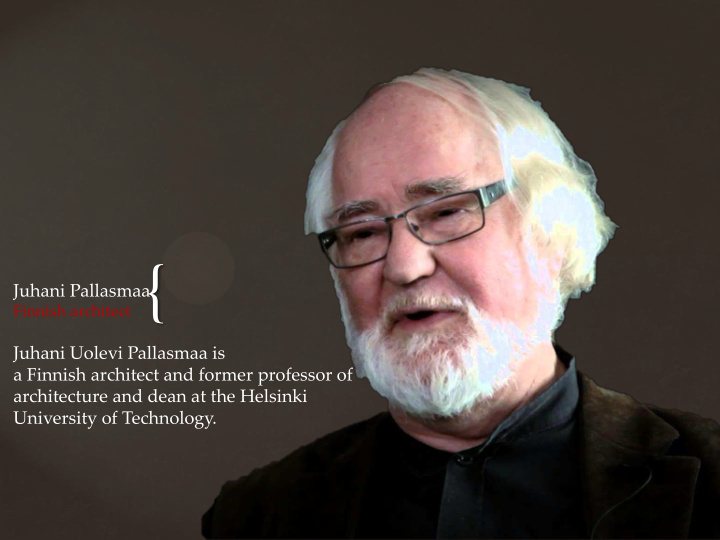



{ Juhani Pallasmaa Finnish architect Juhani Uolevi Pallasmaa is a Finnish architect and former professor of architecture and dean at the Helsinki University of Technology.
Juhani Pallasmaa Finnish architect Born: September 14, 1936 in Hämeenlinna, Finland Full Name: Juhani Uolevi Pallasmaa Education: 1966: Helsinki University of Technology, Master of Science in Architecture
Juhani Pallasmaa Finnish architect ABOUT JUHANI PALLASMAA IN AN INTERVIEW: He promotes a back-to-basics, evolutionary approach to architecture that has become revolutionary in the 21st century. He told interviewer Rachel Hurst that computers have been misused to replace human thought and imagination. "The computer has no capacity for empathy, for compassion. The computer cannot imagine the use of space," he has said. "But the most important thing is that the computer cannot hesitate. Working between the mind and the hand we often hesitate, and we reveal our own answers in our hesitations." Pallasmaa also suggests that architects and designers read novels and poetry to better understand architecture. Juhani Pallasmaa’s Book List is an eclectic mix of unexpected titles. "In my view, literature and the arts provide deep lessons on the essences of the world and life," he told Designers & Books . "Because architecture is fundamentally about life, I find the literary classics, or any fine novels and poems, to be essential books on architecture."
Juhani Pallasmaa Finnish architect WRITINGS AND TEACHING: In spite of the many architecture projects he has completed, Pallasmaa may be best- known as a theorist and educator. He has taught at universities all over the world, including Washington University in St. Louis, Missouri. He has written and lectured extensively on cultural philosophy, environmental psychology, and architectural theory. His works are read in many architecture classrooms around the world.
Juhani Pallasmaa Finnish architect HIS BOOKS AND WORKS: Questions of Perception Phenomenology of Architecture tries to explain the role human perception and phenomenological experience play in architecture.
Juhani Pallasmaa Finnish architect HIS BOOKS AND WORKS: The Embodied Image: Imagination and Imagery in Architecture All artistic and architectural effects are evoked, mediated and experienced through poeticised images. These images are embodied and lived experience that take place in ‘the flesh of the world', becoming part of us, at the same time that we unconsciously project aspects of ourselves on to a conceived space object or event. Artistic images have a life and reality of their own and they develop through unexpected associations rather than rational and causal logic. Images are usually thought of as retinal pictures but profound poetic images are multi-sensory and they address us in an embodied and emotive manner. Architecture is usually analysed and taught as a discipline that articulates space and geometry, but the mental impact of architecture arises significantly from its image quality that integrates the various aspects and dimensions of experience into a singular, internalised and remembered entity. The material reality is fused with our mental and imaginative realm. The book is organised into five main parts that look at in turn: the image in contemporary culture; language, thought and the image; the many faces of the image; the poetic image; and finally the architectural image. The Embodied Image is illustrated with over sixty images in pairs, which are diverse in subject. They range from scientific images to historic artistic and architectural masterpieces. Artworks span Michelangelo and Vermeer to Gordon Matta-Clark and architecture takes in Modern Masters such as Mies van der Rohe, Le Corbusier and Alvar Aalto, as well as significant contemporary works by Steven Holl and Daniel Libeskind.
Juhani Pallasmaa Finnish architect HIS BOOKS AND WORKS: The Embodied Image: Imagination and Imagery in Architecture An introduction to reading architecture and architectural drawings. Each building is presented with a clear architectural plan and images that allow the reader to understand the project's key features.
Juhani Pallasmaa Finnish architect HIS BOOKS AND WORKS: The Eyes of the Skin First published in 1996, The Eyes of the Skin has become a classic of architectural theory. It asks the far-reaching question why, when there are five senses, has one single sense - sight - become so predominant in architectural culture and design? With the ascendancy of the digital and the all-pervasive use of the image electronically, it is a subject that has become all the more pressing and topical since the first edition's publication in the mid-1990s. Juhani Pallasmaa argues that the suppression of the other four sensory realms has led to the overall impoverishment of our built environment, often diminishing the emphasis on the spatial experience of a building and architecture's ability to inspire, engage and be wholly life enhancing.
Juhani Pallasmaa Finnish architect SOME OF HIS ARCHITECTURE WORK: 2004: Snow Show (with Rachel Whiteread), Lapland
2004: Snow Show (with Rachel Whiteread), Lapland
Juhani Pallasmaa Finnish architect SOME OF HIS ARCHITECTURE WORK: 2003-2006: Kamppi Centre, Helsinki.
Juhani Pallasmaa Finnish architect SOME OF HIS ARCHITECTURE WORK: 2002-2003: Bank of Finland Museum, Helsinki 2002: Pedestrian and cycle bridge, Viikki Eco-village, Helsinki 1989-91 Major extensions to Itäkeskus Shopping Centre, Helsinki 1990-91: Outdoor spaces for Ruoholahti Residential Area, Helsinki 1986-1991: Institut Finlandais (with Roland Schweitzer), Paris 1987: Phone Booth Design for Helsinki Telephone Association 1986: Renovation of Helsinki Old Market Hall, Helsinki 1984-1986: Renovation of the Art Museum in Rovaniemi 1970: Summer atelier of artist Tor Arne, Vänö Island
Juhani Pallasmaa Famouse Quotes
Juhani Pallasmaa Famouse Quotes
Juhani Pallasmaa Famouse Quotes
Juhani Pallasmaa Famouse Quotes
REFERNCES: http://www.uiah.fi/studies/history2/world. htm https://www.thoughtco.com/juhani- pallasmaa-finnish-architect-177421
Recommend
More recommend